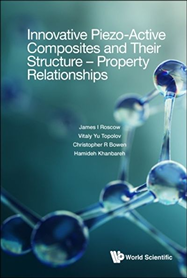Innovative Piezo Active Composites and Their Structure Property Relationships
Material type: TextLanguage: English Publication details: Hackensack, NJ : World Scientific, c2023Description: xxvii, 226 p. : illISBN:
TextLanguage: English Publication details: Hackensack, NJ : World Scientific, c2023Description: xxvii, 226 p. : illISBN: - 9789811261596
- 537.2446 ROS
| Item type | Current library | Collection | Shelving location | Call number | Copy number | Status | Date due | Barcode |
|---|---|---|---|---|---|---|---|---|
 Reference Collection
Reference Collection
|
Reference Section | Department of Materials Engineering | Reference Section | 537.2446 ROS | 2023-24 | Available | 98544 |
AUTHORS
James Iain Roscow is Lecturer and a Prize Fellow in Materials Science and Engineering at the University of Bath. He worked in the industry before obtaining a PhD in ferroelectric composites for energy harvesting and storage within the Department of Mechanical Engineering at the University of Bath. He has published extensively on the processing and physical properties of porous ferroelectric ceramics for piezoelectric energy harvesting and the effect of local electric field inhomogeneities on the dielectric properties of ferroelectric composites for capacitive energy storage. His research interests include the design, fabrication and properties of modern functional composites for sensing, actuation, harvesting, and storage applications.
Vitaly Yuryevich Topolov is Professor at the Department of Physics at the Southern Federal University (Rostov-on-Don, Russia). Among his many past appointments, he was a visiting scientist at the Moscow State University, University of Saarland, Aachen University of Technology, Karlsruhe Research Center, University of Bath and University of Rome Tor Vergata. His research interests include heterogeneous ferroelectrics, smart materials, domain and heterophase structures, as well as electromechanical effects in ferroelectrics and related materials. He is an author of seven monographs, editor of two other monographs, and author of over 480 scientific papers, reviews, conference proceedings and abstracts. He was named Honorary Co-worker of Higher Professional Education of the Russian Federation (Ministry of Education and Science of the Russian Federation, Moscow, Russia, 2009), Member of the International Biographical Centre Top 100 Educators (Cambridge, UK, 2010) and Top 100 Scientists (Cambridge, UK, 2012).
Christopher Rhys Bowen is Professor at the Department of Mechanical Engineering of the University of Bath. After his PhD in 1994 under Prof. Brian Derby, he researched at the Technical University of Hamburg-Harburg, University of Leeds and the Functional Materials Group at the Defence Evaluation and Research Agency (DERA) before being appointed to his current position. His research interests are concerned with modern functional materials, including ferroelectric ceramics and piezo-active composites for modern sensors and actuators, as well as with manufacturing and characterisation of these materials. He has authored five monographs and over 450 scientific papers and conference proceedings. Among his many awards are the Thornton and Hazelwood prizes for academic work (1986–1990), Institute of Materials National Lecture Competition award (1993), SET award (2002), John Willis award for excellence in research and teaching (2003), and an ERC Advanced Fellowship in Novel Energy Materials, Engineering Science and Integrated Systems (NEMESIS, Grant Agreement No. 320963).
Hamideh Khanbareh is Lecturer and a Prize Fellow in Materials Science and Engineering at the University of Bath. During her PhD at Delft University of Technology, working on functionally graded ferroelectric ceramic-polymer composites, she was also appointed visiting scientist at the Molecular Electronics Research Group at Max Planck Institute for Polymers (MPIP) in Mainz. Her main research interests are in materials design, modelling, fabrication and application of piezoelectrics and pyroelectrics in sensing and energy harvesting. Heterogeneous polymer-ceramic composites, offering a wide range of compositional and microstructural design flexibility, are the target of her current research. She has been a member of IOM3 Smart Materials & Systems Committee (SMASC), Institute of Electrical and Electronics Engineers (IEEE) Ferroelectrics as well as Royal Society of Chemistry and UK Society of Biomaterials.
SUMMARY
This monograph provides researchers, engineers, postgraduates and lecturers working in the field of ferroelectric or piezoelectric and related materials with features of the structure–property relationships in modern piezo-active composites. These are piezoelectric composites which are active dielectric materials, which can be poled ferroelectric ceramics or domain-engineered single crystals poled along specific crystallographic directions. Current knowledge of the effective physical properties of these materials is lacking especially due to gaps of information in physical, chemical, microgeometric and technological factors. For composite and transducer design purposes, the expected properties of these piezo-active materials have been theorized through models by the authors and proven in experiments. Various well-known journals have published this research, among many others: Smart Materials and Structures; Journal of Physics D: Applied Physics; IEEE Transactions on Ultrasonics, Ferroelectrics, and Frequency Control; Acta Materialia.
The book summarises and generalises a series of authors' works on the problem of the effective properties and related parameters of modern two- and three-component piezo-active composites wherein the microgeometric factor plays the dominating role. Specific examples of the performance of composites based on domain-engineered single crystals are also discussed. New trends are described in the research of modern piezo-active composites with the aim of filling the gaps in piezoelectric materials science. The primary goal of the book is to show advantages of different methods being applied to manufacture and study the functional composites that are suitable for piezoelectric energy harvesting, hydroacoustic, sensor, actuator, and other transducer applications.
